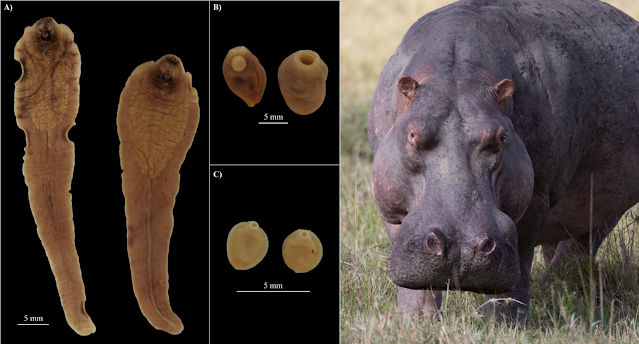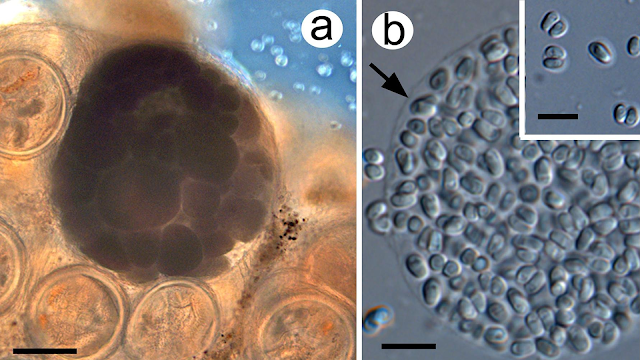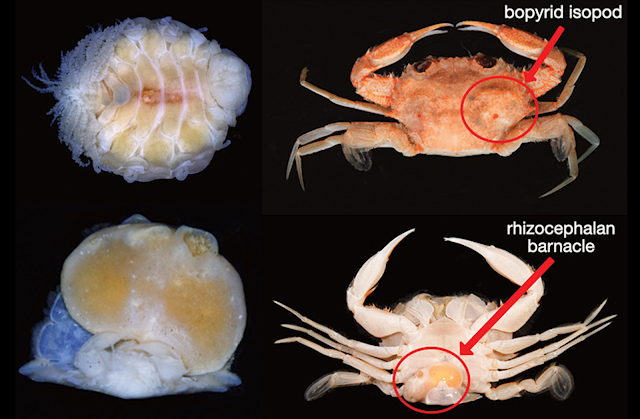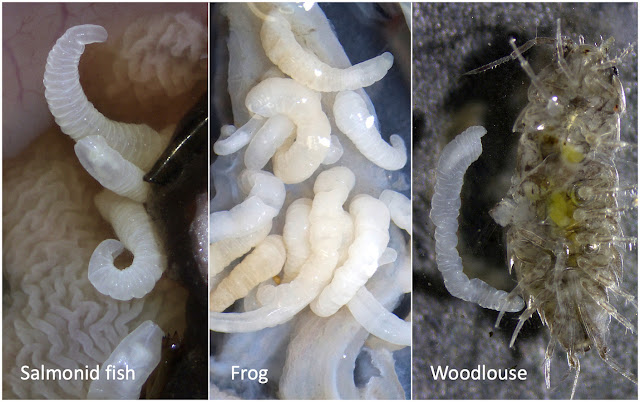Tasmanian Devil is a cute marsupial that packs a mean bite. This charismatic carnivore is found throughout the island of Tasmania and is the largest living carnivorous marsupial. However, it is also currently under threat from the Devil Facial Tumour Disease (DFTD) - which is caused by a peculiar lineage of cancer cells that have evolved to be infectious, able to transmit from host to host, and reproduce itself in each new host along the way. Genetically speaking, this transmissible cancer is essentially a very weird Tassie devil mutant that has evolved to be a single-celled, asexually reproducing, highly virulent pathogen that specifically targets Tassie devils.
But this blog post isn't about the DFTD, instead it is about a unique tapeworm that has been living quietly in the Tassie devil's gut. Unlike the transmissible cancer which is a recently evolved mammalian cell line that is highly lethal and cause grotesquely visible pathology at later stages of infection, this tapeworm has coevolved and cohabited with the Tassie devil for a very long time, and despite its abundance, it is rather innocuous to the host, and is completely hidden from plain sight.
 |
| Left: Tassie devil photo by Mathias Appel in Public Domain, Right: Photos of the Anoplotaenia dasyuri tapeworm provided by and used with permission from Dr Diane Barton |
Anoplotaenia dasyuri is one of six species of tapeworms which have been reported from the Tassie devil, two of which are native to Australia, and A. dasyuri is one of them. The other one is Dasyurotaenia robusta - a rare tapeworm which has the distinction of being one of the only parasites listed as a protected species. In contrast to D. robusta, A. dasyuri is a rather common tapeworm, often found in the Tassie devil in huge numbers. In addition to the Tassie devil, the adult stage of this tapeworm is also occasionally found in the spotted quoll, and with the introduction of cats and dogs to Australia, A. dasyuri has adopted them as hosts as well. However, it seems the Tassie devil is still the tapeworm's preferred host, as they are only ever present in low numbers in those other host species, and A. dasyuri that grew up in dogs were found to be underdeveloped and emaciated. Only in the Tassie devil can these tapeworms thrive and flourish to their full potential.
Like other tapeworms, A. dasyuri needs to infect different host animals to complete its life cycle, and the larval stage are usually found in various macropodid marsupials including wallabies and pademelon, where it resides mostly in the heart muscles. On one occasion, there was a wallaby that was found to have 85 tapeworm larvae in its heart. These animals act as ideal intermediate hosts for the tapeworm's larval stages, as pademleon and other medium-sized macropods are commonly eaten by the Tassie devils. Additionally, old museum specimens indicates that larvae this tapeworm might have even infected the muscles of the extinct thylacine, though it is unclear what role (if any) the thylacine played in the life cycle of this tapeworm. But they were never found to host any adult A. dasyuri worms, indicating the tapeworm treated the thylacine as a stopover on its journey to the Tassie devil.
In this study we're featuring today, researchers from Charles Sturt University examined the innards of Tasmanian Devil carcasses which have been collected over the last ten years and stored in museums. They were all from roadkills which had been donated to museums for scientific studies. From those frozen carcasses, the researchers were able to retrieve jars worth of tapeworms. In total, they were able to pull out 8100 tapeworms from just six infected Tassie devils, which means on average each host was home to about a thousand tapeworms, though the actual numbers in each individual host varied from just two worms to over 4000 worms.
And these researchers had to count and examine each worm individually - that's right, all 8100 of them. They did so in order to check if there were any D. robusta in the mix. Anoplotaenia dasyuri and Dasyurotaenia robusta look very similar to each other, and the key difference between them is the size and shape of the suckers on their respective scolices (attachment organ) - which can only be distinguished under a microscope. So in order to have an accurate count of the tapeworms' numbers and abundance they had to make sure that they were counting the right species.
Perhaps somewhat surprisingly, considering how numerous they can get in the Tassie devils, prior studies reported that these tapeworms cause their hosts very little or no pathologies, even when they occur in massive numbers - which they often do in the thousands. Previous studies have found that even host animals that harboured over fifteen thousand worms seemed remarkably healthy. But then again, unbeknownst to most people, many wild animals are getting through life just fine with an entire colony of parasites inside of them.
Aside from simply recording the number of tapeworms in those Tassie devils, the researchers also used this opportunity to figure out the evolutionary origin of this unique tapeworm. They sequenced sections of the tapeworm's DNA, and compared them with those of other tapeworms in the Cyclophyllidea order. Based on the tapeworm DNA sequences which are available, the closest living relatives of A. dasyuri are tapeworms in the Paruterinidae family, in particular a species from the Cladotaenia genus which was found in a steppe eagle from China.
That doesn't necessarily mean the ancestor of A. dasyuri is from East Asia - very little is known about tapeworms from Australian birds of prey, and there aren't many specimens of tapeworms from Australian raptors available to provide a source of DNA or morphological comparisons. After all, the phylogenetic analysis could only be run against other DNA sequences which are available on Genbank - the global genetic sequence database.
So it is quite likely the actual closest relatives of A. dasyuri are found among Australian raptors. It is worth noting that the diet of a large Australian raptor - the wedge-tail eagle - is rather similar to that of the Tassie devil. So it is possible that at some point in the distant past, the Tasmanian Devil picked up the ancestor of A. dasyuri from sharing a meal with those birds of prey. Those tapeworm larvae might have been waiting to catch a flight in the gut of an eagle, but they ended up finding an equally hospitable home in the gut of the Tassie devil.
Jumping into taxonomically disparate hosts seems to be a common way for parasites like tapeworms to evolve, for example, another tapeworm featured earlier this year on the blog seem to have made a jump from birds to electric fishes, and a few years ago, I wrote a post about a thorny-headed worm which jumped host from sea lions to penguins.
Anoplotaenia dasyuri is not alone in having an interesting evolutionary history - in fact the Tasmanian Devil appears to be home to a peculiar suite of parasites, each as unique as the host itself. Aside from the very abundant A. dasyuri and the very rare D. robusta tapeworms, the Tassie devil is also host to some unusual roundworms, such as a species of pinworm - a family of nematodes which are usually found in herbivorous or omnivore animals with hindgut fermentation, and a species of Baylisascaris - a genus of roundworm which is usually associated with placental carnivore mammals such as bears, raccoons, and mustelids.
So protecting the Tassie devil isn't just about protecting a lone species of marsupial, it is an evolutionary treasure trove that is home to a menagerie of evolutionary unique weirdos and misfits, hailing from a continent known for its unique fauna. Saving the Tassie devil also means saving its posse of worms, each of them representing a disparate legacy of evolution.
Reference:
Barton, D. P., Zhu, X., Lee, V., & Shamsi, S. (2021). The taxonomic position of Anoplotaenia dasyuri (Cestoda) as inferred from molecular sequences. Parasitology 148: 1697-1705.










